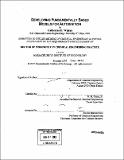| dc.contributor.advisor | W.H. Green, Jr. | en_US |
| dc.contributor.author | Wijaya, Catherina D. (Catherina Dewi) | en_US |
| dc.contributor.other | Massachusetts Institute of Technology. Dept. of Chemical Engineering. | en_US |
| dc.date.accessioned | 2006-03-29T18:34:26Z | |
| dc.date.available | 2006-03-29T18:34:26Z | |
| dc.date.copyright | 2005 | en_US |
| dc.date.issued | 2005 | en_US |
| dc.identifier.uri | http://hdl.handle.net/1721.1/32326 | |
| dc.description | Thesis (Ph. D.)--Massachusetts Institute of Technology, Dept. of Chemical Engineering, 2005. | en_US |
| dc.description | Includes bibliographical references (p. 166-173). | en_US |
| dc.description.abstract | There is renewed interest in autoignition, especially due to the recent development of the homogenous charge compression ignition (HCCI) engine, highly promising with its low Nox and particulate emissions and high efficiency. However it is difficult to control HCCI autoignition. In general accurate prediction of the autoignition behavior of fuel/air mixtures has been difficult, due to inadequate knowledge of low temperature (< 1000K) oxidation. The reactions of peroxy radical RO₂ are hydroperoxyalkyl radical .QOOH are especially problematic. In the first part of this thesis we compute rate parameters for three important reaction pathways from the .QOOH: .QOOH cyclization to form cyclic ether and .OH, .OH migration in .QOOH, and [beta]-scission of [gamma].QOOH. These reactions are competitive with the main chain branching pathway, so their rate constants affect the ignition timing of the system. There are no direct measurement experimental results available for these reactions. We used quantum chemistry, mainly the complete-basis-set extrapolation (CBS-QB3), and calculated the rate constants using the well-known transition state theory (TST). The effects of substituent, nature of radical center, and ring size were also studied. Generalized rate estimation rules for these reactions were derived for later use in automated generation of oxidation mechanisms. The second part of this thesis reports the construction of a rate rules library and rate rules trees for the major reaction families in combustion, useful for automated generation of reaction mechanisms. A detailed oxidation mechanism consists of thousands of reactions, and building such a large mechanism is a laborious task if done manually by hand. | en_US |
| dc.description.abstract | (cont.) Using a hierarchical library of rate estimation rules allows fast on-line estimation of the rate constant of each reaction generated. We derived > 800 rate rules for 14 major reaction families, with emphasis on reaction families important in oxidation. Most of the rate rules were derived from literature kinetic data. These rate rules are stored in a library, based on the reactant classifications in rate rules trees. | en_US |
| dc.description.statementofresponsibility | by Catherina D. Wijaya. | en_US |
| dc.format.extent | 173, 45 p. | en_US |
| dc.format.extent | 14349286 bytes | |
| dc.format.extent | 14363121 bytes | |
| dc.format.mimetype | application/pdf | |
| dc.format.mimetype | application/pdf | |
| dc.language.iso | eng | en_US |
| dc.publisher | Massachusetts Institute of Technology | en_US |
| dc.rights | M.I.T. theses are protected by copyright. They may be viewed from this source for any purpose, but reproduction or distribution in any format is prohibited without written permission. See provided URL for inquiries about permission. | en_US |
| dc.rights.uri | http://dspace.mit.edu/handle/1721.1/7582 | |
| dc.subject | Chemical Engineering. | en_US |
| dc.title | Developing fundamentally based models for autoignition | en_US |
| dc.title.alternative | Business potential of the improved oxidation model and automated reaction mechanism generation software | en_US |
| dc.type | Thesis | en_US |
| dc.description.degree | Ph.D. | en_US |
| dc.contributor.department | Massachusetts Institute of Technology. Department of Chemical Engineering | |
| dc.identifier.oclc | 61368652 | en_US |
